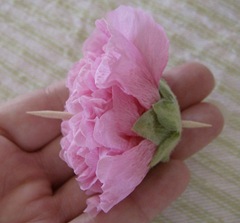
Many of my vegetables are coming in late and small, even the zucchini. I am
trying not to ruminate on the fact that I was canning this time last year. Trying being the operative word! When I am not indulging in a pity party, I am focusing on recipes that will highlight the few, small veggies that I do have.One of my favorites is Vegetable Lasagna, which uses a little bit of lots of different vegetables. Perfect for my 2 small zukes and 4 roma tomatoes. I also used fresh herbs from my garden, homegrown onions and garlic, and spinach that I froze when I was being overrun last month. Just writing that list make me feel a little bit better about my vegetable garden.
If you have been fortunate enough to be overrun with yellow squash and zucchini, then visit
here for a
compilation of recipes that feature summer squash.
Ingredients (please don't be overwhelmed by the list):
12 lasagna noodles ( I used rice noodles to make this gluten free))

2 tablespoons olive oil , divided
2 small zucchini, thinly sliced
1 head broccoli, finely chopped
2 carrots, julienned
1 large onion, chopped
1/2 cup chopped green bell pepper
2 small zucchini, thinly sliced
6 cloves garlic, minced
1/2 cup all-purpose flour (I use gluten free flour)
3 cups milk
1/4 cup butter
1 cup Parmesan cheese, divided
oregano
basil
garlic powder
pepper
1 (10 ounce) package frozen chopped spinach, thawed
1 (8 ounce) container small curd cottage cheese
15 ounces ricotta cheese
4 –5 roma tomatoes, thinly sliced
1/4 cup fresh basil, shredded
3 - 4 cups shredded mozzarella cheese, divided
Directions:
1. Heat oil in a large skillet over medium heat. When oil is hot add zucchini. Add a dash of oregano, basil, garlic powder and pepper. Sauté for 5 –7 minutes. Place zucchini in a dish, but do not rinse out the pan.
2. Reheat the remaining oil in the large skillet adding a little more if necessary. When oil is hot add broccoli, carrots, onions, bell peppers, and garlic. Add a several dashes of oregano, basil, and pepper. Sauté for 6 - 8 minutes; set aside.
3. Bring a large pot of lightly salted water to a boil. Add lasagna noodles and cook for 10 minutes or until al dente; drain.
4. Melt butter in a medium saucepan. Stir in flour (or cornstarch) then gradually whisk in milk until well blended. Bring to a boil over medium heat. Cook 5 minutes, or until thick, stirring constantly. Stir in 1/2 cup Parmesan cheese and add a dash or two of pepper. cook for 1 minute or until cheese is melted. Remove from heat; stir in spinach. Reserve 1/2 cup spinach mixture for the topping.
5. In a small bowl combine cottage and ricotta cheeses; stir well.
6. Preheat the oven to 375 degrees and coat a 9 x 13 pan with a light coat of oil.
7. Spread about 1/2 cup of spinach mixture in the bottom of the prepared pan. Layer noodles, ricotta mixture, zucchini, 2 cups of mozzarella cheese, vegetables, spinach mixture, and end with another layer of noodles. Top with reserved spinach mixture, a layer of tomatoes, basil, 1 - 2 cups mozzarella cheese and 1/2 cup parmesan cheese.
8. Bake at 375 degrees for 30 – 40 minutes, or until lightly browned on top. Cool for approximately 10 minutes before serving. Serves 12.

To view more recipes inspired by homegrown vegetables, visit
Grow. Eat. $ave. at
$5 Dinners.































